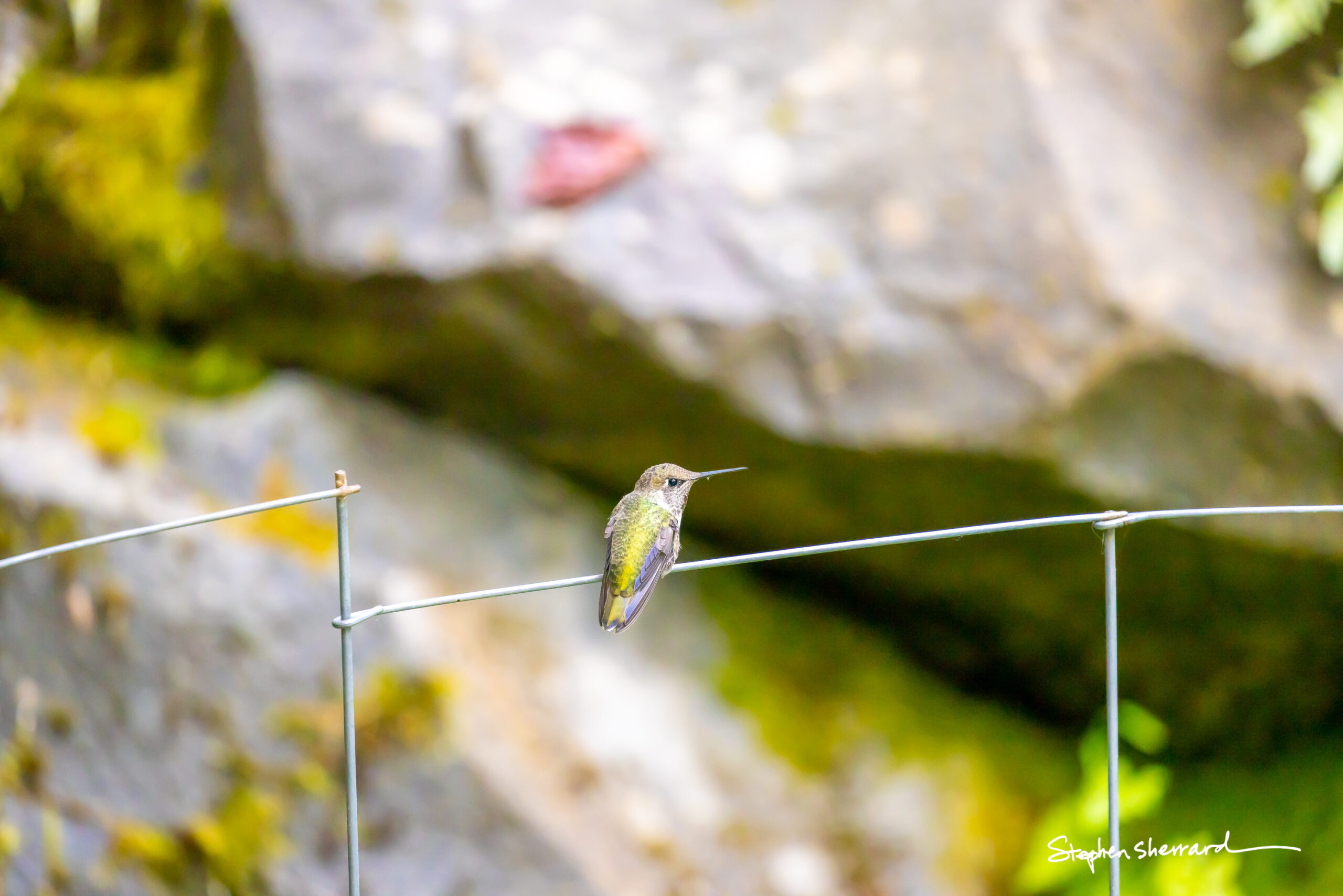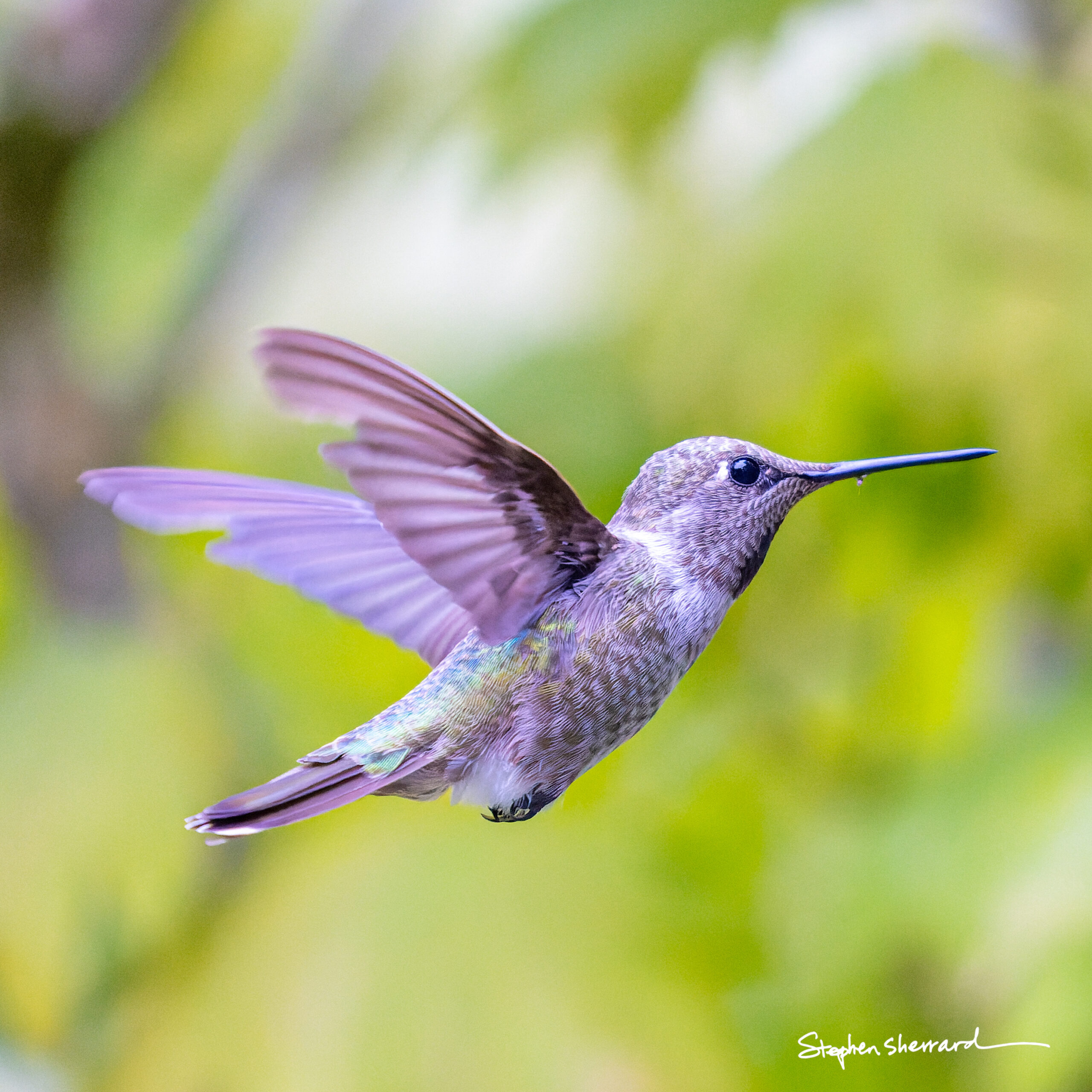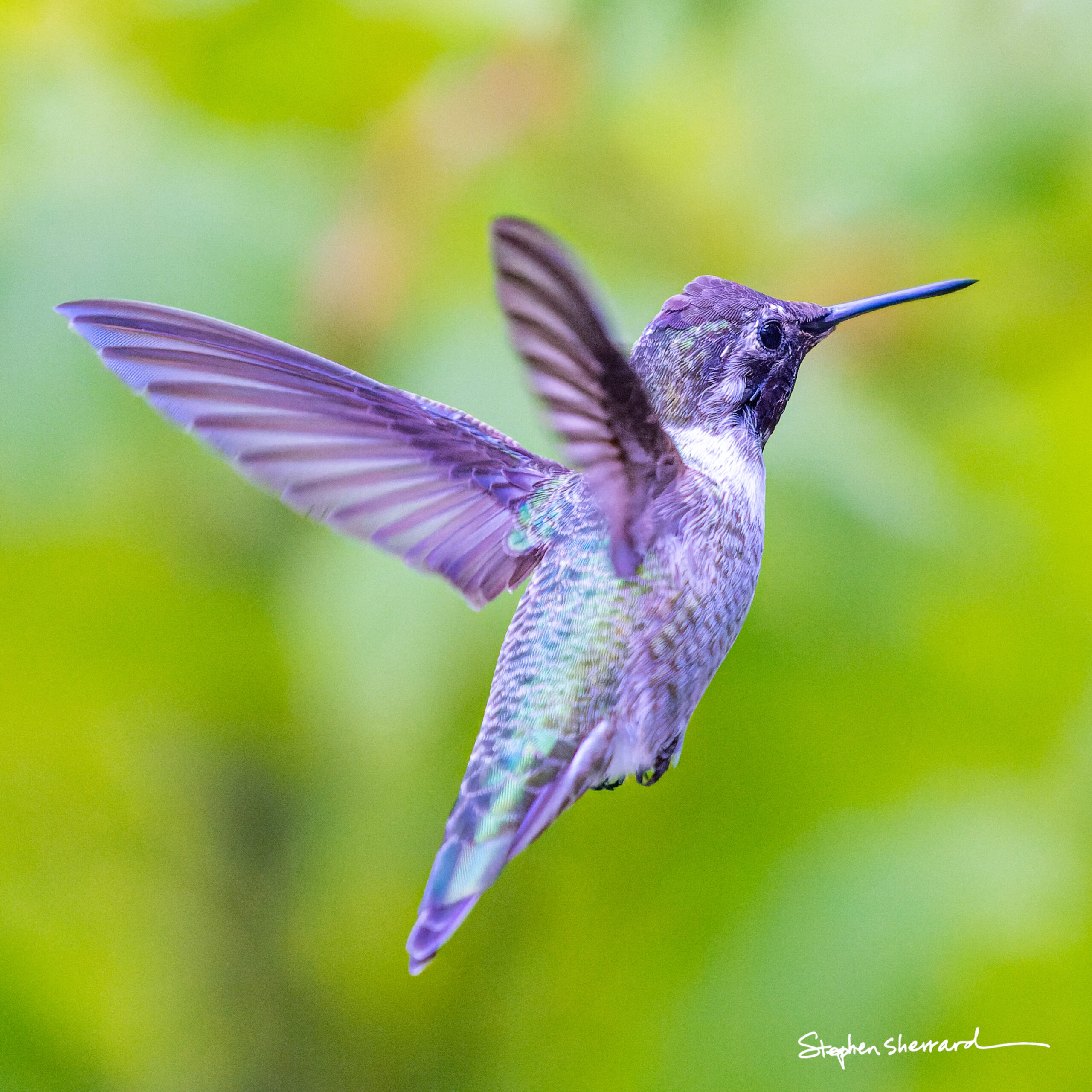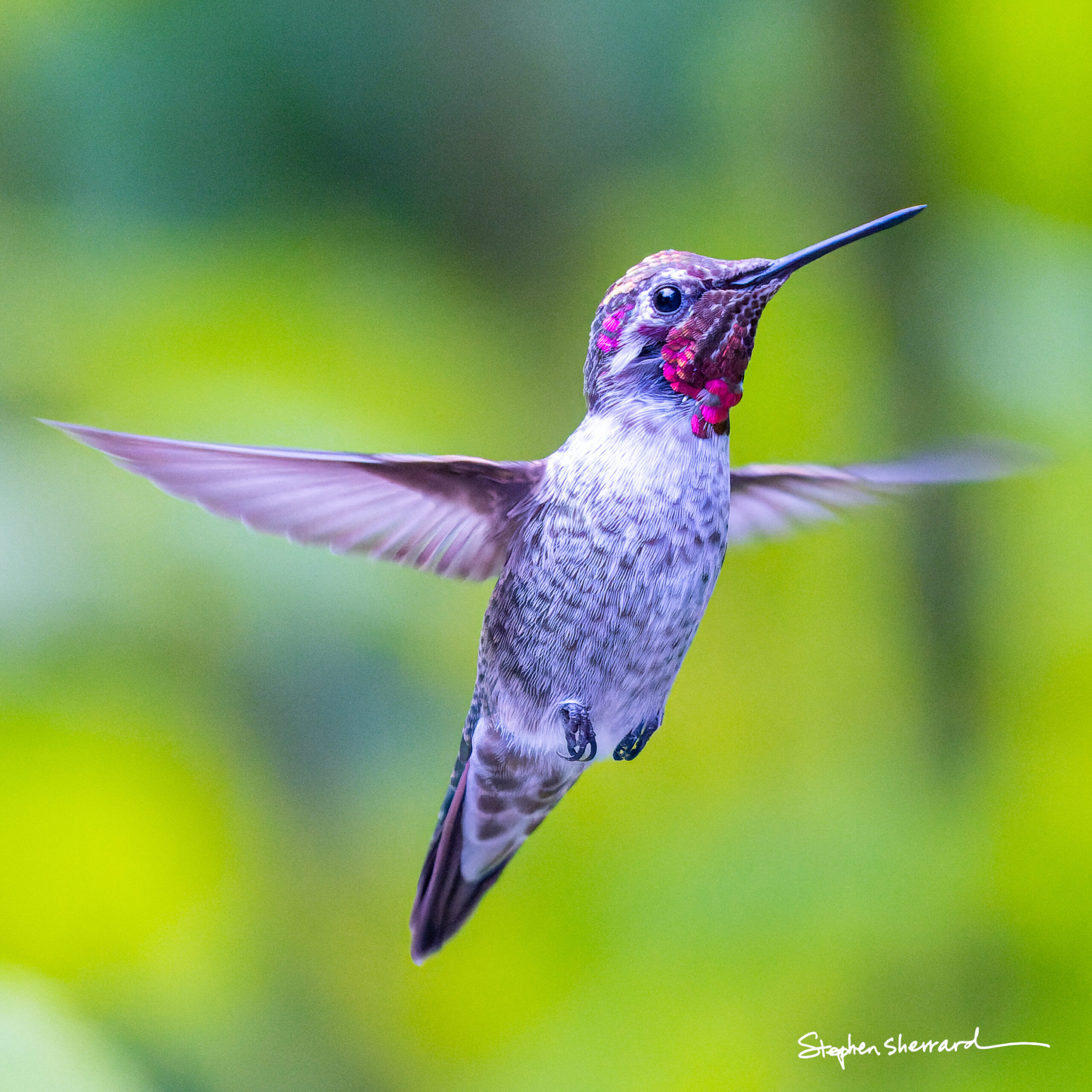Getting good photos of hummingbirds in flight requires fast shutter speeds, which often means you will need to shoot at higher ISOs than you would for other subjects, especially if it's not a bright sunny day, or if you are in a shaded area.
Our backyard garden is in the shade for the majority of the day, and we only get direct sunlight, in a few spots in the garden, for an hour or two when the sun is directly overhead, which is not the best light for photographs. So, if I wanted to get my shutter speed up above 1/2000 when zoomed in to 400mm, at f5.6, I was routinely having to crank up the ISO to at least 6400 on sunny days, and often up to 16000 or more when it was cloudy (more often than not).
Before I discovered this "secret", I would simply just avoid taking photos at anything over about ISO 3200. The noise reduction controls in Adobe RAW, in Lightroom and Photoshop, did just an OK job of removing noise, but always at the sacrifice of softening the image. If you then try to use the sharpening controls to bring back more sharpness, that just increased the noise again. It was always a struggle to find a good setting for those controls, especially if you are having to crop in tight on small subjects, like hummingbirds, so that the noise becomes even more obvious.
I started reading about various software that used AI (artificial intelligence) and complex camera and lens profiles to process images for noise removal and sharpening. I downloaded the trial version of DxO PureRAW and was so blown away by the results that I immediately purchased it, and later also purchased the upgrade to version 2. This completely changed the way I photograph hummingbirds, and I now don't worry about going over ISO 3200, often going up to ISO 16000, or higher. I even tried it out at the max ISO of 51200, and the results were more than good enough for use on the web. I started telling several of my photographer friends about it, and they were all as blown away as I was and bought their own copies.
The newer DxO PureRAW2 integrates as a plugin in Lightroom, if you like to sort through your photos in Lightroom first. My preferred method, though, is to first do a quick in-camera sorting of my images, deleting the missed shots and out of focus shots, then I dump them all to a folder on my computer and batch process those images through DxO PureRAW2. The processed images are saved in a sub-folder or the original images as DNG files. I then import those DNG images into Lightroom to do all my final adjustments, which include exposure and color adjustments and cropping, and then export the final images from there.
Possibly the only negative to DxO PureRAW2 is that it's completely automatic, and you can't fine tune what it does. Some other reviewers say that they think the sharpening sometimes goes too far for their tastes, but I love the way it works on my hummingbird photos, as well as other photos that I have run through it. If you do want to have more control over the settings, they offer the more expensive DxO PhotoLab6, which has the same technology (the new version has a newer DeepPrimeXD mode, but I couldn't tell the different from the regular DeepPrime mode when I tried it out), but let's you make adjustments to the settings. I'm still more used to working with Adobe products, so I didn't need the whole PhotoLab program, and I am very happy with the automatic settings of PureRAW2.
Note that Topaz Labs has just introduced its Photo AI suite of tools, which also includes AI assisted denoise and sharpen processes. I downloaded the trial and gave it a try (but couldn't save the results with the demo version). It also does a very good job of reducing noise, and has a feature where it will detect the subject, and then it seems to remove even more noise from the background areas. But, it was almost too much for me, and not as natural looking as PureRAW2. If all the noise is completely removed, it almost looks fake. With really high ISO shots, PureRAW2 doesn't attempt to remove all the noise, but what it leaves behind is very natural looking, almost like real film grain. I also thought that the sharpening and enhancing features of Photo AI started to produce unnatural artifacts quite quickly. But, that was with the very difficult test image that I used for the samples below. If I backed way off on the settings, it wasn't too bad. So, if you want a bit more control, and don't mind paying a bit more, you may also want to try out the demo of Photo AI. I'm sticking with PureRAW2, though, also because I didn't see any kind of batch mode with Photo AI, which I really love using with PureRAW2 (dump 100 or so photos on it, start it processing and come back 10 minutes later or so, and it's all done).
Note that for either software, you'll get the best results if you are working with RAW files. If you're serious about photography, you should already know that you should be shooting in your camera's RAW format to give you the most flexibility and best looking results when you do your photo editing. PureRAW2 also offers several modes, but you will almost always want to use its DeepPrime mode, which is the most advanced and gives the best results.
But, don't take my word for it, download the demo and try it for yourself. Note, I'm not getting paid by DxO labs for this article, and I did purchase the software and the upgrade myself. However, I did join their affiliate program, and if you click on one of the links in this article to their site, I might earn a tiny bit of money. So, I do appreciate your support, but feel free to bypass my links and look it up for yourself, try the demo, and read some reviews. I'm convinced it will change how you take photos, if you aren't already using something similar.
The below gallery shows an image I used to test DxO PureRAW2 as well as the demo versions of PhotoLab6 and Photo AI. The image I shot is a worst-case scenario, on a cloudy day, in a particularly shady area of our backyard garden, with a relatively dark background with some large rock surfaces where the noise would be very obvious. You can see the full-size image, and then the rest of the images are zoomed in to 100%, so you can really see the noise and the differences in processing. I do zoom in quite a bit for my photos, but never to 100% like these, but that's the best way to show off what the software can do. Note that it doesn't remove all the noise, but the result is much better than what I could accomplish in Lightroom spending several minutes tweaking the noise reduction and sharpen settings of Adobe RAW. I also include an un-processed version of the RAW image so you can see how much noise there was to start with (I set the colors and exposure settings the same, but did not do any sharpening or noise reduction).
Compare the last two images in the gallery below to see the difference between PureRAW and Lightroom for noise reduction, sharpening, and lens corrections. To my eyes, the DxO PureRAW version is much better than Lightroom, and I didn't have to spend any time tweaking the settings. With Lightroom, I spent several minutes with all the settings trying to get as close as I could to what PureRAW2 did. As you can see, PureRAW2 did not try to completely remove all the noise, but what's left behind is very natural looking, and would not be noticeable at all if you weren't looking at 100% zoom. But, what's more important to me, as that the image remains sharp without any artifacts. When you look at the Lightroom version, look at the bit of spider web (or maybe insect) on the beak. All the detail in that is lost. Also look at the wire the bird is setting on and notice the fringing artifacts. In addition, the colors are a bit more washed out and you lose some of the contrast of colors on the bird. All my contrast and exposure settings were mostly the same, but when Lightroom does the lens correction is seemed to brighten the image up more than DxO did (for vignetting), so I reduced the exposure a touch to make it look roughly the same as the DxO version, but it's still a bit more washed out with less contrast. You can see some of that difference in the full size image as well. It's worth noting that DxO builds AI profiles based on the combination of camera and lens together, while Lightroom and Photoshop only offer correction based on the lens. So, as you look at the two full size photos, you can see the geometry and exposure correction is a bit different in the two (I prefer the DxO version).





Below is another gallery of shots taken on the same days as the above gallery, all still at ISO 16000, but in a part of the garden that wasn't as dark, and so not as challenging. These are all 3000x3000 pixel shots that I used for my Instagram account, so they are not cropped in quite as much as the above test shot, but still cropped in quite a bit. For these shots, that had a better exposure to begin with, you barely notice any noise at all, until you zoom in to 100% (even then, the noise that remains is very natural looking).






Below is a small gallery of recent images taken at more "reasonable" ISO settings and processed through DxO PureRAW2. Most of the time, I'm shooting with ISO in the 3200 to 10000 range, which then gives even better/cleaner/sharper results through DxO PureRAW2. Of course, you can always view many more photos on the Hummingbird Photos page, or on my Instagram account, all of which were also processed through DxO PureRAW2.